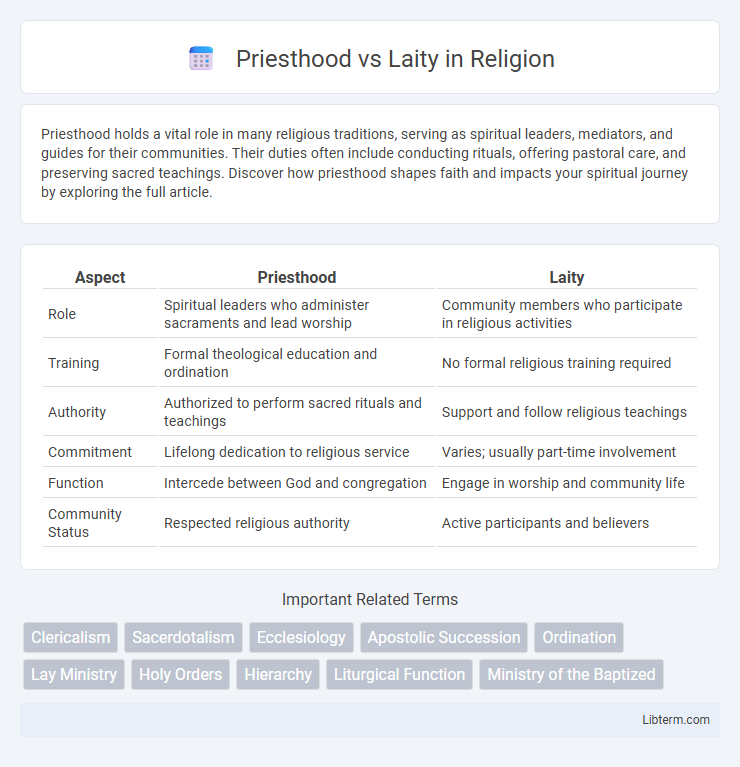Priesthood holds a vital role in many religious traditions, serving as spiritual leaders, mediators, and guides for their communities. Their duties often include conducting rituals, offering pastoral care, and preserving sacred teachings. Discover how priesthood shapes faith and impacts your spiritual journey by exploring the full article.
Table of Comparison
| Aspect | Priesthood | Laity |
|---|---|---|
| Role | Spiritual leaders who administer sacraments and lead worship | Community members who participate in religious activities |
| Training | Formal theological education and ordination | No formal religious training required |
| Authority | Authorized to perform sacred rituals and teachings | Support and follow religious teachings |
| Commitment | Lifelong dedication to religious service | Varies; usually part-time involvement |
| Function | Intercede between God and congregation | Engage in worship and community life |
| Community Status | Respected religious authority | Active participants and believers |
Defining Priesthood and Laity
Priesthood refers to the specific religious office or order entrusted with performing sacred rites, administering sacraments, and leading spiritual worship within many Christian traditions. Laity encompasses all baptized members of the church who are not ordained clergy, participating in the community through various forms of service and daily witness. The distinction centers on ordained authority and sacramental roles for priests, while laity engage in faith practice outside formal clerical duties.
Historical Evolution of Roles
The historical evolution of priesthood and laity roles reflects significant shifts in religious authority and community participation from early Christianity to modern times. Initially, the priesthood held exclusive sacramental and doctrinal functions, while the laity engaged primarily as passive congregants. Over centuries, reforms such as the Protestant Reformation and Vatican II fostered greater participation of laypeople in liturgical life, governance, and evangelism, redefining the dynamic between ordained clergy and the broader faith community.
Scriptural Foundations
The Scriptural foundations of Priesthood vs Laity are rooted in passages such as 1 Peter 2:9, which describes believers as a "royal priesthood," emphasizing the priestly role of all Christians. Hebrews 5:1-10 distinguishes the ordained priesthood, highlighting Christ as the eternal high priest who mediates between God and humanity. This duality reveals a theological framework where the clergy serve sacramental and ministerial functions, while the laity participate actively in worship and spiritual service, both grounded in biblical teachings.
Key Responsibilities and Duties
Priesthood responsibilities include administering sacraments, conducting liturgical services, offering spiritual guidance, and leading religious education within the community. The laity participate in worship, engage in ministry activities, support church functions, and embody faith in daily life through service and evangelization. Clear distinctions in duties emphasize ordained priests' sacramental authority versus laity's role in active church involvement and community witness.
Clerical Authority vs Lay Participation
Clerical authority in the priesthood centralizes religious leadership, granting priests exclusive rights to perform sacraments and interpret doctrine, which establishes a hierarchical structure within many religious traditions. Lay participation emphasizes the active involvement of non-ordained members in church decision-making, worship, and community service, promoting a more inclusive and participatory approach. Balancing clerical authority and lay involvement shapes the dynamics of power, governance, and spiritual engagement within faith communities.
Education and Formation Differences
Priesthood education emphasizes extensive theological training, pastoral formation, and spiritual discipline to prepare candidates for sacramental duties and leadership roles within the Church. Laity formation focuses on lay ministry, biblical literacy, and practical catechesis to support active participation in parish life without sacerdotal responsibilities. The distinction lies in the depth and scope of clerical formation versus the broader, more accessible educational programs designed for lay members.
Spiritual Leadership and Guidance
Priesthood embodies the formal spiritual leadership within religious communities, entrusted with administering sacraments, interpreting sacred texts, and providing authoritative guidance to the laity. The laity, while not ordained, actively participate in worship and community life, embodying spiritual growth through personal faith and service. The dynamic between priesthood and laity fosters a collaborative environment where ordained ministers guide, inspire, and support congregants in deepening their spiritual journeys.
The Role of Laity in Modern Churches
The role of laity in modern churches encompasses active participation in worship, community outreach, and decision-making processes, reflecting a shift towards shared responsibility alongside the priesthood. Lay members increasingly lead ministries, organize charitable activities, and contribute to theological discussions, promoting a collaborative church environment. This empowerment of laity enhances congregational engagement and supports the church's mission in contemporary society.
Challenges and Controversies
The ongoing challenges between priesthood and laity center on issues of authority, decision-making, and doctrinal interpretation within religious institutions. Conflicts often arise over laity demands for greater inclusivity and transparency, contrasted with priesthood emphasis on tradition and hierarchical control. These controversies fuel debates about the role of clergy, lay participation in governance, and evolving religious practices in modern communities.
Future Perspectives on Priest-Laity Relations
Future perspectives on priest-laity relations emphasize increased collaboration and shared ministry roles within the Church. Technological advancements foster virtual communities enhancing laity participation and spiritual formation beyond traditional parish boundaries. Emerging models advocate for decentralized leadership, empowering laity to contribute actively to pastoral care and decision-making processes.
Priesthood Infographic

 libterm.com
libterm.com